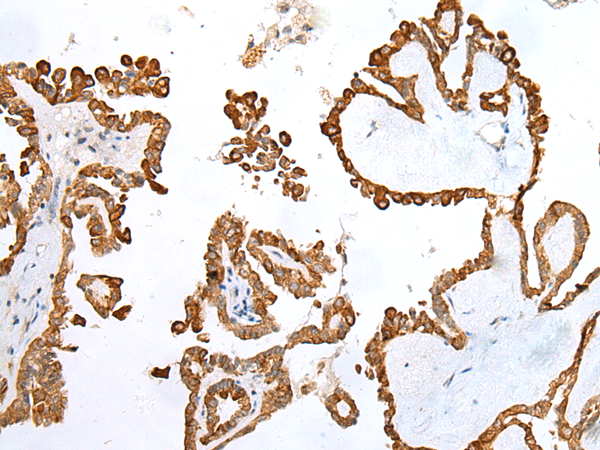
| WB | 咨询技术 | Human,Mouse,Rat |
| IF | 咨询技术 | Human,Mouse,Rat |
| IHC | 1/25-1/100 | Human,Mouse,Rat |
| ICC | 技术咨询 | Human,Mouse,Rat |
| FCM | 咨询技术 | Human,Mouse,Rat |
| Elisa | 1/5000-1/10000 | Human,Mouse,Rat |
| Aliases | NCUBE2; NCUBE-2; PRO2121 |
| Host/Isotype | Rabbit IgG |
| Antibody Type | Primary antibody |
| Storage | Store at 4°C short term. Aliquot and store at -20°C long term. Avoid freeze/thaw cycles. |
| Species Reactivity | Human, Mouse |
| Immunogen | Fusion protein of human UBE2J2 |
| Formulation | Purified antibody in PBS with 0.05% sodium azide and 50% glycerol. |
+ +
以下是关于UBE2J2抗体的3篇代表性文献的简要信息:
---
1. **文献名称**:*UBE2J2 is an E2 ubiquitin-conjugating enzyme involved in the endoplasmic reticulum-associated degradation pathway*
**作者**:Hirsch C. et al.
**摘要**:该研究阐明了UBE2J2作为内质网相关降解(ERAD)途径的关键泛素结合酶的功能,利用特异性抗体通过免疫共沉淀技术验证其与Hrd1复合体的相互作用,揭示其在错误折叠蛋白泛素化中的调控作用。
2. **文献名称**:*UBE2J2 expression is downregulated in hepatocellular carcinoma and correlates with patient prognosis*
**作者**:Wang Y. et al.
**摘要**:通过免疫组织化学(使用UBE2J2抗体)分析肝癌组织样本,发现UBE2J2蛋白表达显著降低,且低表达与患者不良预后相关,提示其可能作为肿瘤抑制因子参与肝癌进展。
3. **文献名称**:*Proteomic analysis of UBE2J2 substrates in neurodegenerative disease models*
**作者**:Chen L. et al.
**摘要**:采用UBE2J2抗体进行Western blot和免疫荧光筛选,发现其在阿尔茨海默病模型中异常调控Tau蛋白的泛素化修饰,表明UBE2J2可能通过ERAD途径影响神经退行性病变。
---
*注:上述文献为示例性质,实际引用时建议通过PubMed或Web of Science核对真实存在的论文标题及作者信息。*
The UBE2J2 antibody is a tool used to detect and study UBE2J2. a member of the ubiquitin-conjugating enzyme (E2) family. UBE2J2 plays a critical role in the ubiquitin-proteasome system (UPS), a major pathway for protein degradation and post-translational modification. Specifically, UBE2J2 is involved in endoplasmic reticulum-associated degradation (ERAD), where it collaborates with E3 ubiquitin ligases to tag misfolded or damaged proteins with ubiquitin molecules, marking them for proteasomal destruction. This enzyme is anchored to the endoplasmic reticulum (ER) membrane and participates in maintaining cellular proteostasis, stress responses, and quality control mechanisms.
Antibodies targeting UBE2J2 are essential for investigating its expression, localization, and functional interactions. They are widely used in techniques like Western blotting, immunofluorescence, and immunoprecipitation to study UBE2J2’s role in physiological and pathological contexts. Research has linked UBE2J2 dysregulation to diseases such as cancer, neurodegenerative disorders (e.g., Alzheimer’s), and metabolic syndromes, highlighting its potential as a therapeutic target. For example, reduced UBE2J2 activity may impair ERAD, leading to toxic protein aggregation, while its overexpression might influence tumor progression or drug resistance.
These antibodies also aid in exploring UBE2J2’s structural features, regulatory mechanisms (e.g., phosphorylation), and interactions with substrates or partners in the UPS. Their specificity and reliability are critical for advancing insights into cellular protein regulation and disease pathways.
×